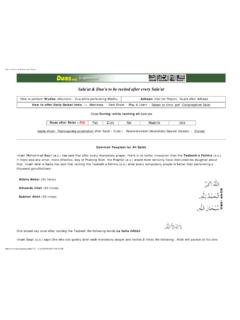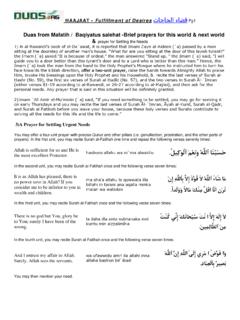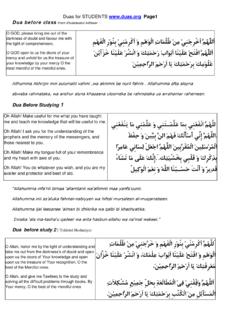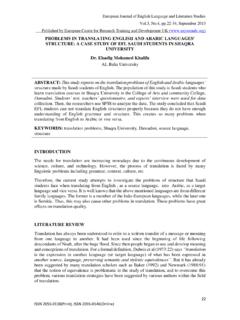Transcription of A step by step guide to learning how to …
1 ReadA step by step guide to learning how to understanding TajweedBook INTRODUCTION TO Q READ 2 .. 1 ARABIC NUMBERS .. 3 STOPPING SIGNS .. 4 SAJADAT OF TILAWAT QUR AN .. 7 DIVISIONS IN THE QUR AN .. 9 SAMPLE OF A QUR AN PAGE .. 11 TABLE OF CHAPTERS IN THE QUR AN .. 12 SOUND ORIGINATION - MAKHARIJ POINTS .. 15 SOUND ORIGINATION LIP LETTERS .. 16 SOUND ORIGINATION TONGUE LETTERS .. 17 SOUND ORIGINATION THROAT LETTERS .. 19 HURUF UL MUQATTA AT .. 20 QUALITIES OF LETTERS SIFAAT AL HUROOF .. 24 GHUNNA .. 26 RULES OF NUN SUKUN AND TANWEEN .. 28 RULES OF NUN SAKIN AND 29 IDGHAAM .. 30 IDH-HAAR .. 34 IQLAAB or QALB .. 35 IKHFAA .. 37 EXERCISE .. 39 SIMPLE SUMMARY OF THE RULES OF NUN SAKIN AND TANWEEN .. 40 RULES OF MEEM SAKIN .. 41 QALQALA .. 43 RULES OF LAAM .. 45 RULES OF RAA .. 46 INTRODUCTION TO Q READ 2 Q READ 2 is the follow up to Q READ 1 and completes the basic rules for recitation of the Qur an with the focus on tajweed . Page 1 Before starting this book, the student should have finished Q Read part 1 and now practicing reciting the Holy Qur an.
2 Q Read 2 begins with recapping on the rules of stopping and a basic introduction to the divisions in the Qur an and Arabic numbers. It follows with the all-important rules of tajweed . Importance of reciting the Qur an correctly Allah also says in the Qur an ..and recite the Qur an as is taught to be recited (lit. with tarteel ). Qur an reading is the recitation of the Qur an according to tajweed & tarteel as taught by the Prophet Muhammad (pbuh). What is tarteel? When asked about the meaning of tarteel, Imam Ali (pbuh) replied: It means that the Qur an should be recited with tajweed and with due observance to the rules of waqf (pausing or stopping at the end of the verse). What is tajweed ? tajweed simply means to recite every letter correctly from its proper origin of pronunciation together with the attribute of its accompanying letters. Just as in any other language, we learn to pronounce the letters and words : in English we learn ph stands for f and not p as in phone/fone and not pne.
3 Similarly in the Arabic language, we also have to learn the proper pronunciation of letters and words which we term tajweed . Thus as a repeated example, the word qalb (with Q) means heart , if read kalb (with K) will now mean dog. tajweed also means to improve and to make better . The recitation and pronunciation of every letter of the Qur an from where the sound is supposed to come with its proper characteristics such as lengthening (isti laa), shortening (istif l), thinning (tarqeeq), thickening (tafkheem) and other phonetic rules such as absorbing/merging (idghaam), pronouncing clearly (idh-haar), changing (iqlab) and hiding (ikhfa). Therefore we could say: tajweed of the Qur an is the knowledge and application of the correct rules of recitation so that the reading of the Qur an is as close as possible to the recitation of the Prophet Muhammad (pbuh). Page 2 ARABIC NUMBERS 1 2 3 4 5 6 7 8 9 01 Although Arabic language is read from right to left, Arabic numbers are read from left to right (as English numbers).
4 For example: 92 = Not 29 145 = Not 541 Write the following numbers in Arabic: 2 = _____ 786 = _____ 9 = _____ 103 = _____ 41 = _____ 2691 = _____ 38 = _____ 3074 = _____ Write the following numbers in English: = _____ = _____ = _____ = _____ = _____ = _____ Page 3 STOPPING SIGNS This chapter is a recap from Q Read 1. It is important to know the correct points at which to stop or continue during recitation in order to not change or distort the meaning of the ayaat. In the Qur an there are some signs or punctuation marks called waqf or in plural wuqoof . These are found in the middle or the end of ayaat and give us an indication of whether stopping/pausing is permitted or not. The most common waqf is: o : End of an aya STOP Sometimes the following letters are placed on the O or in the middle an aya to indicate various rules of stopping Compulsory stop Otherwise meaning is changed Stop End of a section Should stop End of a sentence Better to stop Can stop or continue Must continue, can take a breath Must continue, can take a breath Must continue, can take a breath Better NOT to stop Stop at the first or the second but not at both Better to stop but permissible to continue Better to continue but permissible to stop Page 4 STOPPING ON WORDS Whilst signs are helpful in showing where to stop, pause or continue, this topic will recap on what a break in recitation should sound like.
5 Below is a brief recap of what was covered in Q Read 1. If further explanation or examples are required, please refer to Q Read 1. As mentioned in Q Read 1, there are 5 kinds of stopping or pausing: 1) fatha ( ) , kasra ( ) , dhamma ( ) , kasra tanween ( ), dhamma tanween ( ) vowel is read as a sukun. o o 2) When the word ends with a letter that has a fatha tanween ( ) followed by or , The letter will be recited as a long vowel fatha (2 counts) o Page 53) If the word ends with a ta marbuta ( ), it is changed to a haa with a sukun. o 4) If the word ends with a sukun ( ) , it stays the same. o 5) If the word ends with a long vowel ( , , ) , it stays the same.
6 O Page 6 SAJADAT OF TILAWAT QUR AN There are 14 places in the Qur an where sajadat is to be performed. 4 are wajib and 10 are mustahab. There are 4 wajib sajadat: On hearing or reciting any of the following 4 ayaat, one must perform a sajda. It is not necessary to face qibla, or be in wudhoo. The 4 wajib sajadat are: Suwer Aya Juz 32. As Sajda (The Adoration) 15 21st 41. Hameem Sajda 38 24th 53. An Najm (The Star) 62 27th 96. Al Alaq (The Clot) 19 30th MNEMONIC: When a star 53 is born96 do 2 sajda s32 & 41 There are 10 mustahab sajadat: On hearing or reciting the aya, it is recommended that one performs a sajda; it is recommended and not wajib. The 10 mustahab sajadat are: Suwer Aya 7. Al A raf (The Elevated Places) 206 13. Ar Ra ad (The Thunder) 15 16. An Nahl (The Bee) 50 17. Bani Israil (The Children of Israil) 109 19. Mariam (Mary) 58 22. Al Haj (The Pilgrimage) 18 25. Al Furqan (The Criterion) 60 27.
7 An Naml (The Ant) 26 38. Saad (Saad) 24 84. Al Inshiqaq (The Bursting Asunder) 21 I heard thunder13 & looked up7 where I saw an explosion84 it was Israa17 which I had read about in the furqan25. The bees16 and ants27 were scared & Maryam19 went to hajj22 to seek the secret38. Page 7 Although there is no need for any recitation, it is recommended to recite the following in sajda: Indeed there is no god except Allah There is no god except Allah, I believe and have faith in Him There is no god except Allah, My servitude and bondage is to Him To You my Lord I prostrate in servitude and bondage neither with pride nor arrogance. Rather in humility and weakness, I as Your abd seek safety with You. In the margins of the Qur an, one will see to indicate the beginning of the aya of sajda and to indicate the end of the aya where one does sajda, or you will see Page 8 DIVISIONS IN THE QUR AN Qur an is organized with respect to the location of revelation of verses, whether in Makka or Madina.
8 Almost two-thirds of the Qur an was revealed in Makka, and carries the title, Makki and the remainder was revealed in Madina and therefore carries the title Madani . The Holy Qur an is divided into ayaat (verses/sentences) and suwer (chapters) JUZ/AJZAA 30 Parts SURA/SUWER 114 Chapters RUKU/RUKUAAT Paragraphs AYA/AYAAT Sentences / Verses AYA ( ): Means a verse or a sentence. The plural is ayaat ( ). There are 6236 ayaat in the Qur an. SURA ( ): The Qur an has 114 chapters. Each chapter is called a sura. The plural is suwer ( ). All suwer begin with Bismillah except sura no. 9 called At-Tawba or the repentance. Bismillah appears twice in Suratun Naml. RUKU ( ): The juz (part) and sura (chapter) are divided into paragraphs/sections. Each paragraph/section is called a ruku. A ruku consists of a number of ayaat all of which deal with one topic. The plural is rukuaat ( ). There are 558 rukuaat in the Qur an. In the margin of the page, you will see the symbol ( ).
9 This is the symbol for ruku. The symbol usually has 3 numbers one at the top, in the middle and at the bottom. (Top) Number of rukuaat in the sura (Middle) Number of ayaat in the ruku (Bottom) Number of r rukuaat in the juz Page 9 Below is a picture of a RUKU. Look it up in the Qur an, you will find it on almost any page on the margin. Number of rukuaat in the sura Number of ayaat in the ruku Number of rukuaat in the juz JUZ ( ) The Qur an is conveniently divided into 30 parts called juz for people who want to finish reciting the Qur an in a month. This is usually written at the top of the page. MANZIL ( ): The Qur an is also divided into 7 parts called manzil ( ) for people who want to finish reciting the Qur an in seven days. This is either written at the bottom of the page or in the margin of the page. Manzil No. 1. Suwer 1, 2, 3 and 4. Manzil No. 2. Suwer 5 to 9. Manzil No. 3. Suwer 10 to 16. Manzil No. 4. Suwer 17 to 25. Manzil No.
10 5. Suwer 26 to 36. Manzil No. 6. Suwer 37 to 49. Manzil No. 7. Suwer 50 to 114 Since all suwer and ayaat within them are numbered, the most scientific method is to provide the sura and aya number. For example, Ayatul Kursi is 2:255 that is sura 2 (Al-Baqara) and aya 255. Some scholars prefer the reference Al-Baqara 255 or Al-Baqara (2): 255. Page 10 SAMPLE OF A QUR AN PAGE A sample of a Qur an page is shown below. Have a look and try to identify the same with other pages from the Qur an. Page number Juz name and number Aya number Manzil (seven division) number Ruku (paragraph) Sura name and number Page 11 TABLE OF CHAPTERS IN THE QUR AN The following table provides information about each chapter contained in the Qur'an Name Translation Makki or Madani Chapter Number of verses Al Fatiha The Opening Makki 1 7 Al Baqara The Cow Madani 2 286 Al Imran The Family of Imran Madani 3 200 An Nisa' The Women Madani 4 176 Al Ma ida The Table Madani 5 120 Al An'am The Livestock Makki 6 165 Al A'raf The Heights Makki 7 206 Al Anfal The Spoils of War Madani 8 75 At Tawba The Repentance Madani 9 129 Yunus Jonah Makki 10 109 Hud Hud Makki 11 123 Yusuf Joseph Makki 12 111 Al Ra'ad The Thunder Madani 13 43 Ibraheem Abraham Makki 14 52 Al Hijr The Rock Makki 15 99 An Nahl The Bee Makki 16 128 Al Israa The Night Journey Makki 17 111 Al Kahf The Cave Makki 18 110 Maryam Mary Makki 19 98 Ta Ha Ta Ha Makki 20 135 Al Anbiya The Prophets Makki 21 112 Al Hajj The Pilgrimage Madani 22 78 Al Mu'minun The Believers Makki 23 118 An Nur The Light Madani 24 64 Al

















